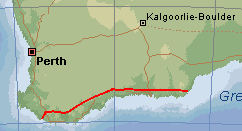Conservation Status

Callitris drummondii
(Parl.) F. Muell. 1882
Common names
Small cypress pine, Drummond's cypress pine.
Taxonomic notes
Syn.: Frenela drummondii Parl. ex Seemann (1863). Type Australia: Western Australia: south-coastal region, J.Drummond 433, ex herb. F. von Mueller (holotype FI). The type specimen was collected sometime between 1829 and 1852, during which time Drummond lived in southwestern Australia and was active in plant collecting. This species shares Clade A of Larter et al. (2017) with C. baileyi; the two species have an estimated divergence of 10 million years ago, i.e. mid-Miocene.
Description
Evergreen shrubs or small trees to 6 m tall and 20 cm dbh, single- or multi-stemmed, with a low-branching conical or rounded crown of spreading to ascending branches. Bark gray, smooth, soon turning scaly, hard and fissured on lower stems. Twigs numerous, ascending, triangular, 1.5-2 mm thick, covered in closely appressed leaves. Leaves yellowish green or green, in alternate whorls of 3, decurrent, closely appressed, linear, 2-6 × 1-1.8 mm on youngest twigs, abaxially smooth or weakly verrucose and keeled, margins denticulate, apex obtuse to acute, stomata in two marginal lines. Pollen cones terminal, solitary or paired, ovoid-oblong, 3-6 × 1.5-2 mm, yellowish green turning light brown. Seed cones terminal on short, 5-6 mm thick leafy shoots, solitary but often grouped along sections of stems, maturing in 1-1.5 years, persistent, globose when closed, 12-15 × 12-17 mm, purplish or metallic gray. Bract scale complexes in 2 whorls of 3, very thick, bract tip minute (only visible in smooth, closed cones), columella very thick, 3-5 mm long. Seeds 2 per scale, 2-3 m long, up to 7 mm including wings, which are on 2 opposite sides, 1-2 and 2-4 mm wide, unequal in shape and size (Farjon 2010).
Distribution and Ecology
Western Australia, 10-250 m elevation, where it experiences a hot Mediterranean climate. Soils are highly variable: clay to sand, laterite or limestone or sandstone; habitat is mainly riparian margins of usually-dry lakes, ditches and watercourses. Vegetation is Melaleuca-dominated scrub thick or low mallee woodland with Eucalyptus spp. (Farjon 2010, Larter et al. 2017).
The IUCN has assigned this species a "Near Threatened" conservation status. It has an extent of occurrence of about 28,000 km2 and an area of occupancy of at least 400 km2, with more than 10 subpopulations. There has been some habitat fragmentation and there is some evidence of long-term decline in population status and habitat quality. Threats include wildfire and domestic grazing animals, but these threats are not particularly imminent or severe, and the species is protected in several national parks and other preserves (Thomas 2013).
Zone 10 (cold hardiness limit between -1°C and +4.4°C) (Bannister and Neuner 2001).
Remarkable Specimens
No data as of 2023.03.03.
Ethnobotany
No uses are recorded, apart from very uncommon ornamental plantings--mainly in botanical gardens (Farjon 2010).
The species does not seem to have been used in dendrochronology. The small size of the species suggests that long ring-width series would likely be difficult to obtain, and the very arid climate might contribute to a high percentage of missing rings, so it would likely be less useful than other Callitris species.
Observations
See the collection records on iNaturalist and the more extensive collections at Florabase.
Remarks
The epithet honors pioneer Australian botanist James Drummond (c. 1786-1863), collector of the type specimen.
Although very little research has been done on this species, the leaf oils have been investigated, and revealed two chemical varieties. Samples from Western Australia contained large amounts of α-pinene (67–69%), while the sample from South Australia contained limonene (10.9%), bornyl acetate (24.2%) and geranyl acetate (14.9%) as significant components. Limonene and α-pinene are primary components of most other Australian Callitris species, but significant amounts of bornyl acetate are seen only in C. endlicheri and C. preissii, and geranyl acetate only in C. rhomboidea (Brophy et al. 2007).
Citations
Brophy, Joseph J., Robert J. Goldsack, Paul I. Forster, Lachlan M. Copeland, Wayne O’Sullivan, and Andrew C. Rozefelds. 2007. Chemistry of the Australian gymnosperms. Part IX. The leaf oils of the Australian members of the genus Callitris (Cupressaceae). Journal of Essential Oil Research 19(1):57–71.
Larter, Maximilian, Sebastian Pfautsch, Jean-Christophe Domec, Santiago Trueba, Nathalie Nagalingum, and Sylvain Delzon. 2017. Aridity drove the evolution of extreme embolism resistance and the radiation of conifer genus Callitris. New Phytologist 215(1):97–112. https://doi.org/10.1111/nph.14545.
Mueller, F.J.H. von. 1882. Systematic Census of Australian Plants, Melbourne: Bird M'Carron. p.109. Available at Internet Archive, accessed 2012.11.24.
Seemann, Berthold. 1863. Podocarpus vitiensis, a new coniferous tree, from the Viti Islands. Journal of Botany 1:35. Available: Biodiversity Heritage Library, accessed 2023.01.04.
Thomas, P. 2013. Callitris drummondii. The IUCN Red List of Threatened Species 2013: e.T34073A2843177. https://dx.doi.org/10.2305/IUCN.UK.2013-1.RLTS.T34073A2843177.en, accessed 2023.01.04.
See also
Farjon (2005) provides a detailed account, with illustrations.


